If you’re looking for a way to password-protect a page in WordPress, we’ve got you covered.
Passwords are the best way to keep your content safe from prying eyes. If you don’t want people to see your blog posts or pages, password-protecting them is a great way to keep them secure.
But with a few different methods for password-protecting pages and content in WordPress, it isn’t easy to know which to choose.
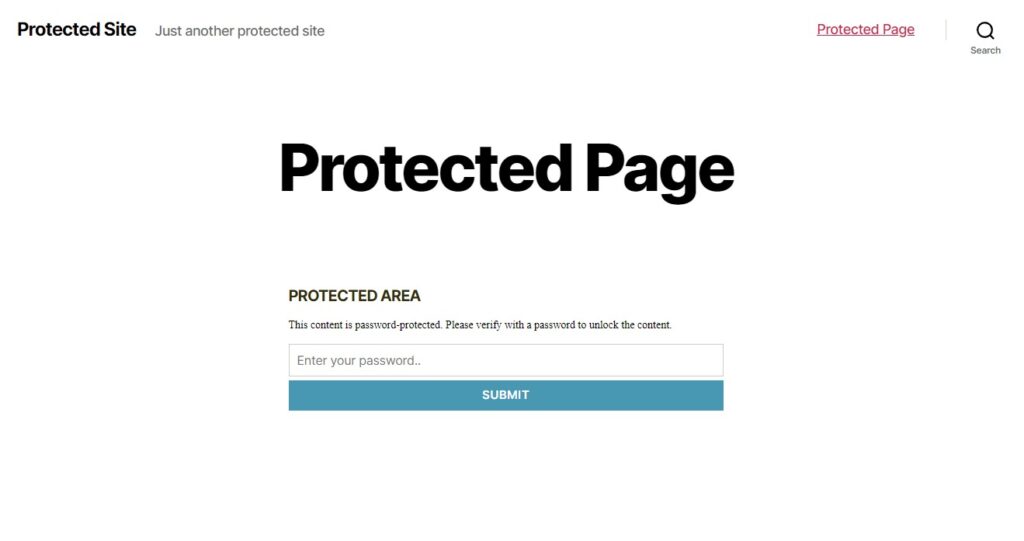
So in this article, we’re going to break it down for you. We’ll cover the following:
- Why you should password protect a page in WordPress.
- How and why you should do it with a plugin (and which plugin to use).
- How to password-protect a page with WordPress’ default settings.
So first things first, let’s address why you might want to password-protect a WordPress page in the first place.
Table of Contents
Why password-protect a page in WordPress
If you want to password-protect a page in WordPress, it’s easy to do. But why would you want to? Well, there are lots of reasons!
You might want to hide sensitive content from those who don’t have permission, for example:
- Customers who haven’t registered with your site yet.
- Employees who don’t need access to that information or function.
- Press who might be visiting your website.
- Website visitors who you don’t want accessing content yet because it’s not ready.
- Or anyone at all because you want your website or blog to be completely private.
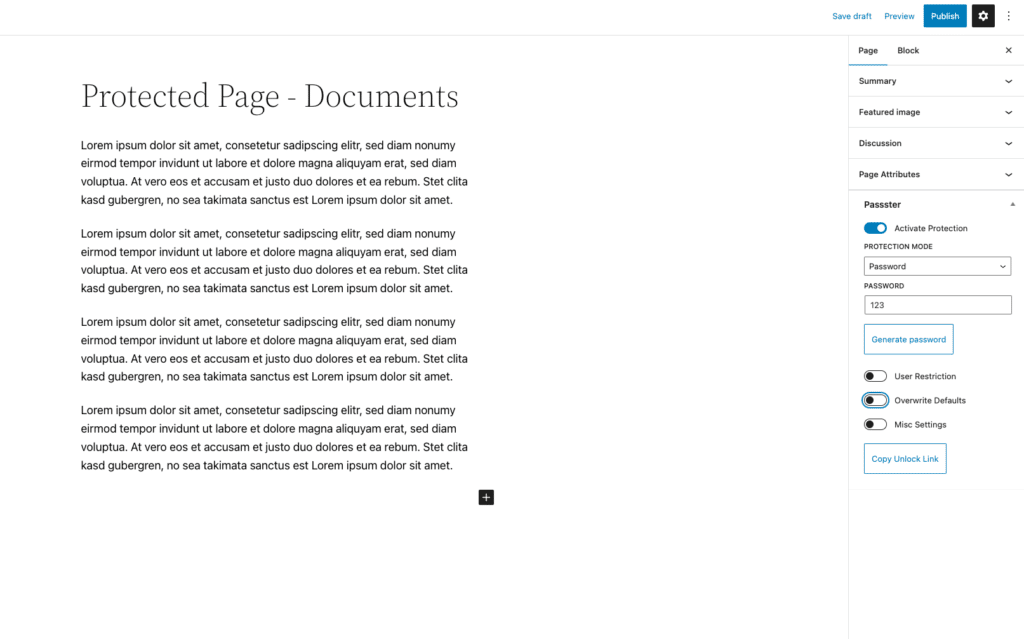
As well as these, you might want to password-protect content on your website because:
- It’s an extra layer of security for sensitive information like customer data and product pricing (if you use WooCommerce).
- It helps protect your sanity when someone over at the office accidentally gets too close to the company holiday party planning folder – they won’t be able to see any of it.
- It prevents people from accidentally messing up important content while they’re working on a project.
Password-protecting a page in WordPress is a great way to add some extra security to your website. But whatever the reason, password-protecting your content should be as secure and easy to set up as possible.
Which is why we recommend using a WordPress plugin to do it, and in the next section, we’ll explain why.
Why use a plugin to password-protect WordPress?
There are a few ways to password-protect a page in WordPress, but the most effective method is to use a plugin.
The default method of password-protecting a page in WordPress is pretty basic. You create one password, and if a user has access to that password (and adds it to the password form), they’re in.
While this method might work for some, it’s not the most secure, especially if you have sensitive information or content you don’t want the world to see. After all, as soon as that one password gets around, you’d have to change the password and inform everyone with access that you’d changed it. By that point, the damage is done.
The solution? Adding a password-protect WordPress plugin to your website instead. The one we recommend is Passster.
Passster
Protect your entire website, entire pages, or just parts of your content with one or more passwords.
The best password-protect page plugin, Passster
With Passster, you can add single passwords, multiple passwords, or password lists to your WordPress content to protect it. Increase that protection with encrypted links, user-role restriction, and CAPTCHA/reCAPTCHA authentication, and you’ve got the most secure password protection you can get.
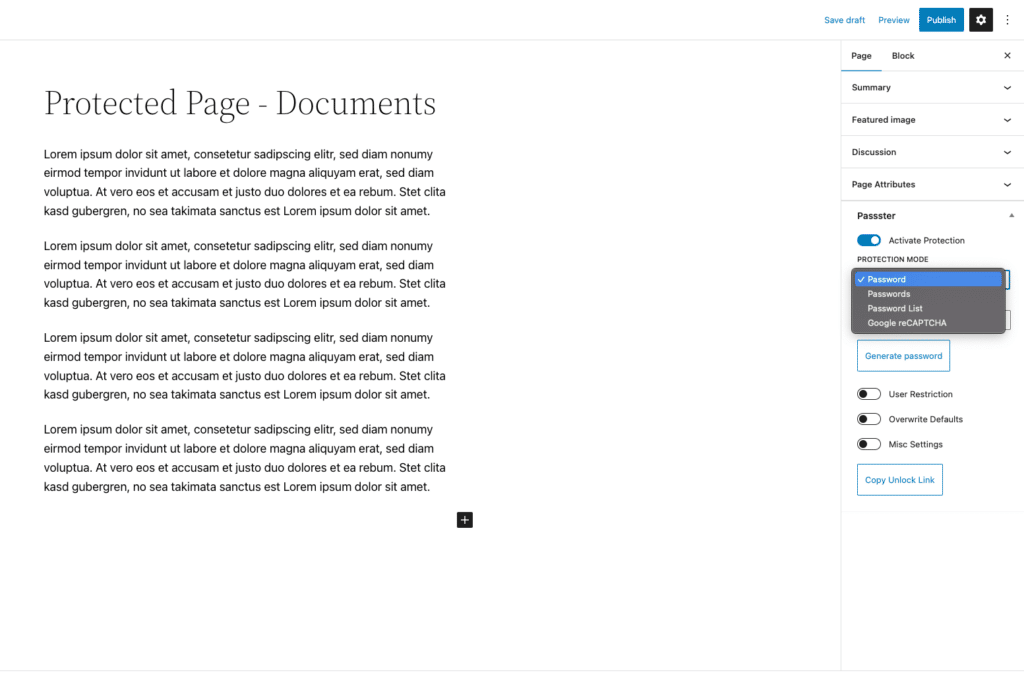
You’ll also be able to track how often a correct password is used simultaneously to prevent abuse and unwanted sharing.
Security is important, so these features really make Passster shine, but with Passster, you’ll also be able to customize what your password-protection form looks like.
Using the built-in WordPress customizer, you can tailor the password-protection form to suit your WordPress site’s style.
Passster doesn’t just password-protect WordPress pages (and custom post types). It can also:
- Protect your entire website with a redirect landing page.
- Protect part of a page or WordPress post with single post/ page content you can add as a shortcode.
- Secure WooCommerce products either by password-protecting them or restricting them by user role to keep your ecommerce store secure.

Passster works with any WordPress theme, template, or page builder, so if you’re looking for the best WordPress password-protection plugin, one that uses an alternative to the WordPress login page, Passter is your best bet.
So let’s get it set up.
How to password protect a page in WordPress
In this tutorial, I’ll show you how to use Passster to password-protect pages on your WordPress website in just a couple of minutes!
Step 1: Install the password-protect plugin Passster
The first thing you’ll need to do before we password-protect content in WordPress is download and install the Pro version of Passster.
Passster
Protect your entire website, entire pages, or just parts of your content with one or more passwords.
Once done, we can move on to password-protecting a WordPress page.
Step 2: Password-protect your chosen WordPress page
To protect a WordPress page, take the following steps:
- From your WordPress admin dashboard, go to Pages > All Pages and click to edit the page you want to protect. Or you can add a new page by clicking Add new.
- In the sidebar on the right, scroll until you get to the Passster section.
- Click the Activate Protection toggle button to protect your page.
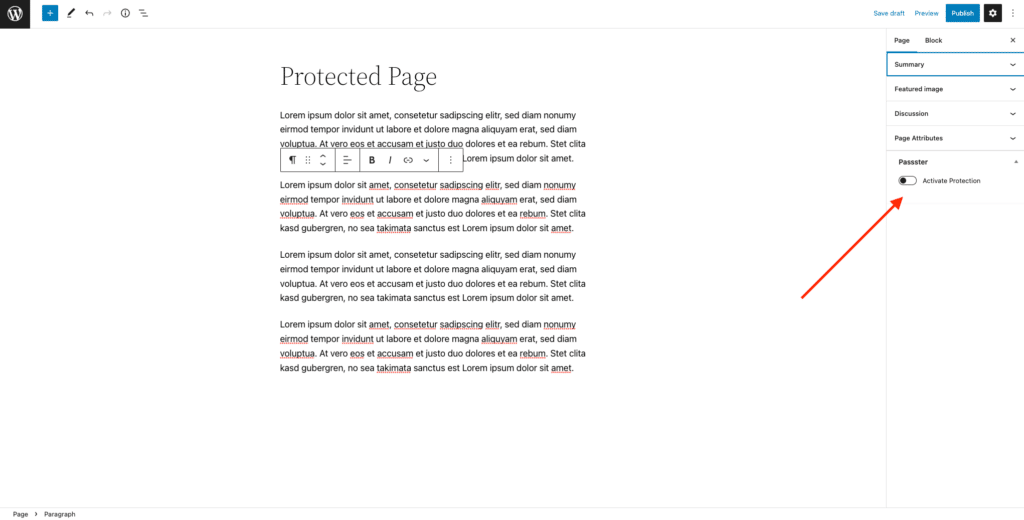
- Once done, we’ll need to pick our protection type in the Protection Type dropdown. In this dropdown, there are six options for you to pick from.
- Password – Set one specific password for users to use and gain access.
- Passwords – Set multiple different passwords for users to gain access. These should be added as a comma-separated list.
- Password List – Select one of your pre-created password lists (you can create these following this guide). By creating a list rather than just using set passwords, you’ll have more control over your password expiry for extra security.
- reCAPTCHA – This doesn’t require a password and instead restricts bots and hackers on the page with invisible or visible reCAPTCHA.

- Once you’ve picked your protection type, you can set a redirection URL in the Redirection field. This will redirect website visitors to another URL (if you want) once they’ve gained access.
- Next, User Restriction. Change the User Restriction Type (Username or User Role) using the dropdown. Then type in which of these you’d like in the User role or username field.
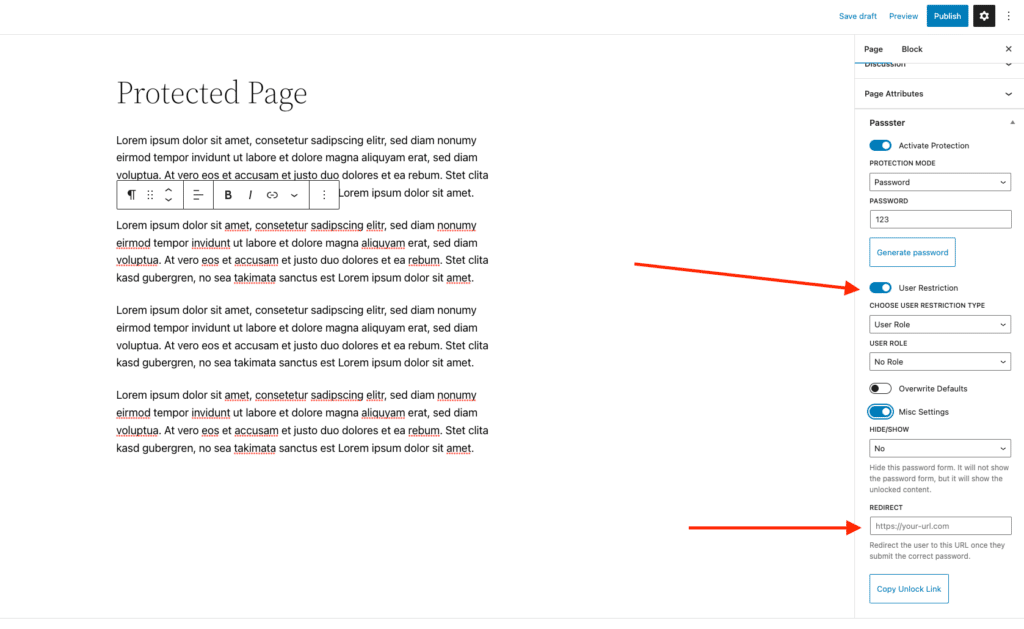
- Once you’re happy, click the blue Publish or Update button at the top of the page and your page will be protected.
Step 3: Customize your password-protection form
After this, you can customize your password-protection form using the settings located in Passster->Settings->Design.
- From your WordPress dashboard, go to Passster->Settings->Design.
- Start customizing the overall design of your password form.
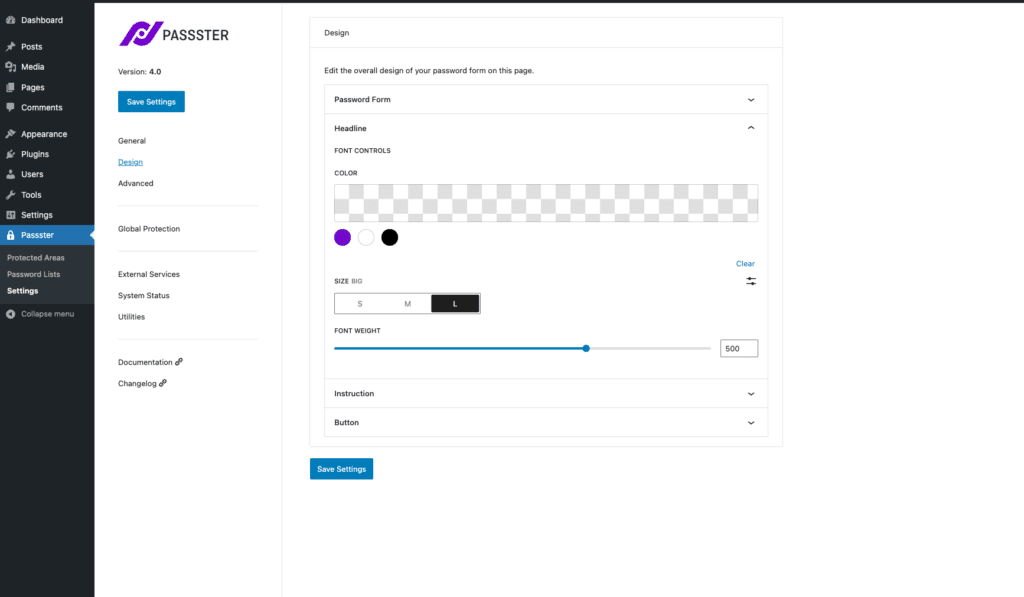
Password-protecting WordPress using a plugin is by far the most secure and easily customizable way to protect your WordPress content.
But if you’re still looking for a plugin-free method, the strategy below uses WordPress’ default settings.
Password protect a page in WordPress without a plugin
If you’re looking to password-protect a page or post in WordPress without the help of a plugin, then take the following steps:
- From your WordPress dashboard, go to Pages > All Pages and click Edit on the page you wish to protect.
- On the right-hand side, you’ll see your post summary (depending on which editor you’re using, Gutenberg or classic).
- Click the link next to Visibility to see your post visibility options.
- Here you’ll see three default options that come with WordPress. Public (visible to everyone), Private (only visible to admin and editors), and Password protected (only visible to people with the password). Click the circle next to Password protected.
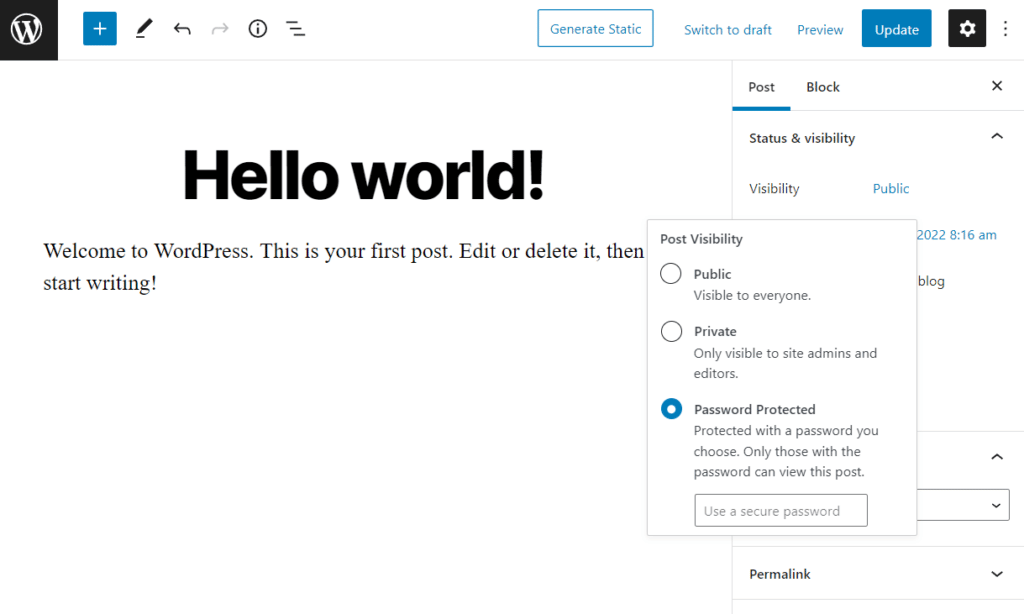
- Once clicked, you’ll see a new field pop up where you can enter your password. This password will then be used by site visitors to gain access to the content on this page.
- After you’ve entered your password, click the blue Update or Publish button at the top of the page, and your page will be protected.
Sadly, the in-built WordPress password-protection form doesn’t allow for much customization. You can still use the WordPress customizer to change some styles, but they will apply across your entire WordPress site.
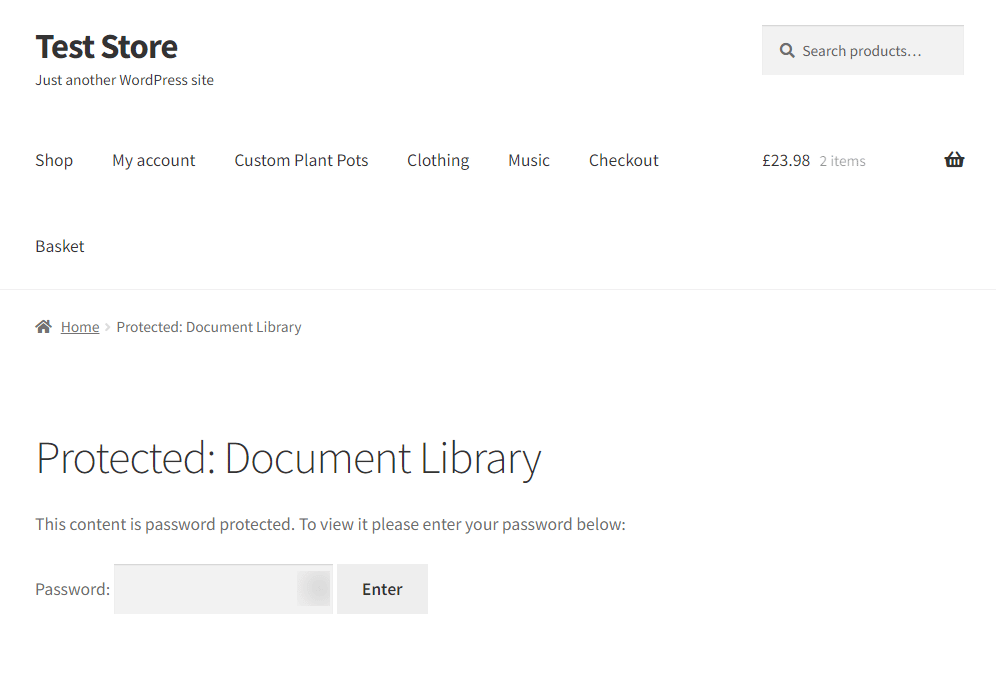
Password protect a WordPress page today
Protecting a WordPress page with WordPress’ default settings works if you’re not too concerned about the content you’re protecting. But if you want more security and customization options, the plugin Passster is your best bet.
You’ll be able to track password usage, protect more than just individual pages, set limits, and generally have a more secure way to password-protect your WordPress content.
Passster
Protect your entire website, entire pages, or just parts of your content with one or more passwords.